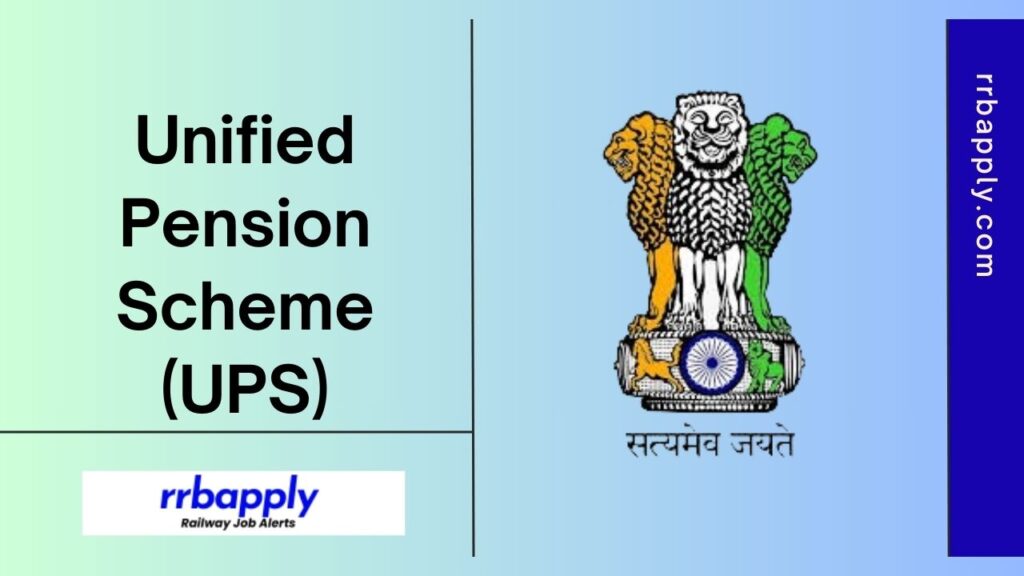Unified Pension Scheme 2024: What could have been better than this from the Government of India. Central Government Employees especially those who have joined the service on or after 01.04.2004 are governed by NPS (New Pension Scheme). So, what is Unified Pension Scheme or UPS that is approved by the cabinet today on 24/08/2024? Let us get into the details of Unified Pension Scheme from an employees point of view,. We the team of rrbapply.com/ shall detail the nitty gritty of the UPS and its effect on the central government employees on this page.
Brief on Unified Pension Scheme 2024
| Authority | Union Cabinet, chaired by the Prime Minister Shri Narendra Modi, |
| Scheme Name | Unified Pension Scheme (UPS). |
| Approval Date | 24th August 2024 |
| Date of Effect | 1st April 2025 |
| Applicable for | 23 Lakh Central Government Employees including Railway Employees |
| Official Notice | Click Here |

What is Unified Pension Scheme or UPS?
UPS or Unified Pension Scheme is a guaranteed pension scheme approved today by the Government of India which shall be applicable from 1st April 2025. Under this scheme, the Government of India has decided that the employees will be entitled to pension on being superannuated from government service. This came as a great relief for the Central Government employees including the Railway Employees.
Note: Existing employees under NPS shall be given an option to switch to Unified Pension Scheme.
Highlights of the Unified Pension Scheme is as under –
- Guaranteed Pension: Employees will get a 50% of the average basic pay drawn over the last 12 months prior to superannuation as pension for a minimum qualifying service of 25 years. This pension amount will be calculate proportionate for a lesser service period up to a minimum of 10 years of service.
- Guaranteed Family Pension: Family Pension @60% of the pension of the employee will be paid immediately after the demise of the pensioner to the family member entitiled.
- Guaranteed Minimum Pension: Employees will be entitled to a minimum pension of Rs.10000 per month on superannuation after a minimum of 10 years of service.
- Inflation Indexation: This means in Old Pension Scheme, the pensioner is compensated due to rising inflation through Dearness Relief with the pension. In case of UPS, the same Dearness Relief shall be paid in the form of pension to compensate with the rising inflation.
- Lump Sum Payment at superannuation in addition to gratuity to be calculated for 1/10th of monthly emoluments (Pay + DA) as on the date of superannuation for every completed six months of service.
Now that Unified Pension Scheme is launched let us check the difference between NPS and UPS that are going to be implemented from 1st April 2025.
UPS vs NPS – Key Differences
Here are the key difference between NPS and UPS that is going to effect the central government employees including Indian Railway Employees.
| Features | Unified Pension Scheme | New Pension Scheme |
| Assured Pension | 50% of the last salary | No such option |
| Family Pension | 60% of the Pension | No such option |
| Government Contribution | 18.5% of the Basic Pay plus DA | 14% of the Basic Pay plus DA |
| Date of Effect | 01.04.2025 | 01.01.2004 |
| Corpus Paid on superannuation | Lump Sum Payment at superannuation to be calculated for 1/10th of monthly emoluments (Pay + DA) as on the date of superannuation for every completed six months of service. | 40% of the Corpus in NPS |
| Gratuity | Applicable | Applicable |
We hope the to the point information is useful for the Central Government Employees and also for the aspirants dreaming to secure job under Govt of India. Thus, further updates on Unified Pension Scheme 2024 will be made available as soon as it is announced by the Government.
FAQs
Unified Pension Scheme is the newest pension scheme approved by the cabinet on 24th August 2024 which shall be applicable w.e.f 1st April 2025.
Yes, the employees on superannuation shall be entitled to 50% of basic as pension under UPS.
Yes, family pension @60% of pension will be paid to the family members after the demise of the pensioner.
